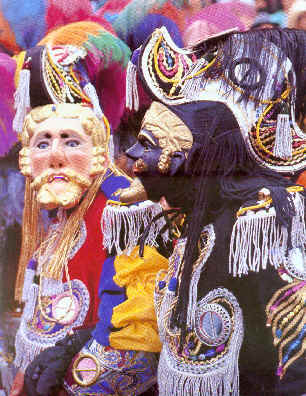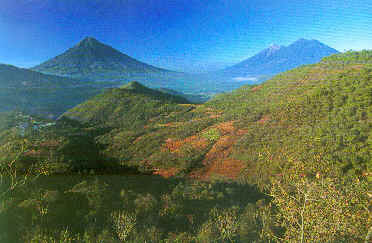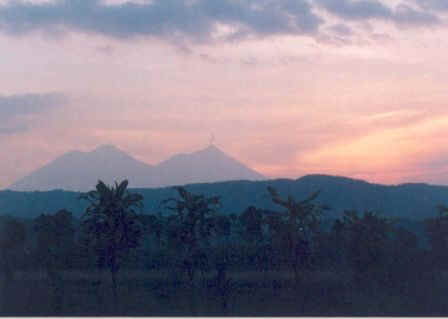
E-mail: font@focusonnature.com
Phone: Toll-free in USA 1-800-721-9986
or 302/529-1876
 |
PO Box 9021,
Wilmington, DE 19809, USA E-mail: font@focusonnature.com Phone: Toll-free in USA 1-800-721-9986 or 302/529-1876 |
THE FOCUS ON NATURE TOUR IN GUATEMALA
December 2005 / January 2006
Our Festive
Holiday Birding & Nature Tour
in the Guatemalan Highlands & Lowlands

Costume Masks, as we've seen
them during our Holiday Tours,
near Antigua in Guatemala

The Guatemalan
Highlands,
where we see Mountain Trogons, and Pink-headed Warblers
Links:
List
of Birds during our Guatemala Holiday Tour - December '05-January '06
Cumulative list of Birds during our previous Guatemala Tours
Upcoming
Guatemala Tour Itineraries
The following account written by Armas Hill, leader
of the tour:
We once again enjoyed our annual
Holiday Birding & Nature Tour in Guatemala from just after
Christmas 2005 to just after New Year's 2006.
Guatemala is a wonderful place to see birds and
experience nature that time of year.

Two Guatemalan volcanoes in the early morning.
(Photographed during our Dec/Jan '05-'06 Guatemala tour
by participant Marie Z. Gardner)
A number of birds seem to like
being there that time of year as well. In the scenic highlands of the country,
in many a tree we would see many a TENNESSEE WARBLER. Birds from both eastern
and western North America winter in the area. Not only are there eastern
BLACK-THROATED GREEN WARBLERS, there are western TOWNSEND'S and HERMIT WARBLERS.
Not only are there eastern SUMMER TANAGERS, there are also WESTERN TANAGERS.
Our tour in Guatemala goes firstly to the highlands, and then to the lowlands of
the Peten Region, where we visit the famed Mayan ruins of Tikal. Now that site
is in an extensive national park that's well-preserved with forest and its
accompanying birds and animals. About a thousand years ago, there were many
people living at Tikal. A civilization is said to have flourished there about
900 A.D. Today, Tikal and other Mayan ruins that we visit in the Peten are
places of visitors. Many come & go each day. Of course, we're visitors also,
but the paths that we follow in the area are not those that most do. We thus had
the opportunity, again, to see close-at-hand the magnificent forest and the
creatures that reside there. Among them, during our recent tour, there were the
animals such as MONKEYS, the AGOUTI and COATI, and even, with good fortune, the
JAGUARUNDI.

Temple at Tikal
There were, during a wonderful
afternoon boat-ride in a more remote region of Peten (that's not on the beat of
most Tikal visitors), CROCODILES and turtles known as SLIDERS at the river's
edge, and, as dusk enveloped us, BATS and NIGHTHAWKS catching insects as they
flew in the beautiful twilight sky.
On the ground in the forest, there were ANTS (LEAF-CUTTERS and others).
BUTTERFLIES included an assortment of SWALLOWTAILS, MOZAICS, ZEBRAS, and
CRACKERS, just to name a few.
And of course, there were BIRDS. There were TROGONS and TOUCANS. There were
WOODPECKERS and WOODCREEPERS (a nice variety of the latter). And there were
MOTMOTS and MANAKINS.
The MANAKINS were among the favorites of the tour. Brilliantly colorful were the
males that we saw so well of the RED-CAPPED and WHITE-COLLARED MANAKINS. If
people like birds, they love MANAKINS, especially when they see them so well.
As we walked in the Peten forest, we were fortunate to have some good
experiences with the birds. It's always good to encounter a FLOCK composed of a
few species as they make their way feeding in the trees. That we did. At one
such time, the colorful "leader of the pack", the BLACK-THROATED
SHRIKE-TANAGER was hard to ignore, as it kept giving its call. But we certainly
had to look at the other birds in the group too, including the FLYCATCHERS,
WOODCREEPERS and WARBLERS, and even the GREENLETS. Some of the FLYCATCHERS were
something to see, notably the NORTHERN ROYAL. Others that we encountered during
the tour included a SPADEBILL and BENTBILL.
Late one afternoon, at one place in the forest, we come upon a lot of ANTS. We
stood still, and the BIRDS came too. Not only the WOOD THRUSH and the
THRUSH-LIKE MANAKIN did we watch closely, but the SHRIKE-TANAGER came in very
close, and the ANT-TANAGERS simply ignored us, as at our feet, they were more
concerned with the ants.
We actually, during our stay in the Peten, watched many WOOD THRUSHES on the
ground. That's good, as we like for there to be many, particularly when they'd
return to North America in the spring, and fill the forest with their beautiful
song. Also the HOODED WARBLERS we liked seeing as well as we did, and knowing
too that they would be adding their beauty to North American forests later in
the year.
Outside the Peten forests, in an open area of fields, we stopped at a place
where in the past, we'd seen some FLYCATCHERS of the open, including the
brilliantly-red VERMILION and the exquisite FORK-TAILED. They were there. The
FORK-TAILED, the Central American subspecies that's resident, is always nice to
see with its very long tail. But there was another long-tailed FLYCATCHER at
that place that was unexpected, as it's not normally there. On the fence posts
and tree stumps there were at least 2 SCISSOR-TAILED FLYCATCHERS, along with the
FORK-TAILED. The also-exquisite SCISSOR-TAILED FLYCATCHER is normally on the
Pacific side of Guatemala. In the Peten region of northeast Guatemala, it has
only occurred historically as a vagrant. This past year, with the strong storm
in Guatemala in October (the disastrous Hurricane Stan), it may have been that
some migrating birds, such as the SCISSOR-TAILED FLYCATCHER, were blown
off-course.
In Guatemala's Peten, as just noted, some unforeseen birds can be found. But,
one species that one can count on if one goes to Tikal is a large bird now
nearly restricted to national parks, the OCELLATED TURKEY. It's easy at Tikal to
walk among them. In the forest there at Tikal, also large, were the walking
GREAT CURASSOWS that we encountered as we were doing the same.
CURASSOWS and TURKEYS, as just noted, are big. On the other hand, among the best
of our smaller birds in Guatemala were the HUMMINGBIRDS. We saw a number of them
with wonderful names that relate to their plumages. Most of them were in the
Guatemalan highlands, where, among those we saw, there were these: the
GARNET-THROATED and AZURE-CROWNED HUMMINGBIRDS, and, as if garnet were not
enough, also the AMETHYST-THROATED HUMMINGBIRD. But probably the best was the
SPARKLING-TAILED WOODSTAR, with the male having a long tail. By Lake Atitlan,
said to be one of the most beautiful places anywhere, that nice little
hummingbird is able to even add to the beauty.
Another hummingbird, among the 15 or so species during our tour, was one also
visiting the area as we were. After RUBY-THROATED HUMMINGBIRDS, from eastern
North America, cross the Gulf of Mexico, a good number of them winter in the
Guatemalan hills.
Another group of birds well-represented during our Guatemala Tour were the
ORIOLES. We saw 8 species: BLACK-COWLED, BALTIMORE, BULLOCK'S, ORCHARD,
BLACK-VENTED, YELLOW-BACKED, YELLOW-TAILED, and ALTAMIRA. Now that's a lot of
bright color.
And there were other colorful birds, of various kinds, during the tour. In the
mountains, there was the ELEGANT EUPHONIA on treetops, and the WHITE-WINGED
TANAGER. The name of that bird does not indicate how brightly red the bird is
overall. More subdued with its redness is the PINK-HEADED WARBLER. Red on its
breast is the SLATE-THROATED REDSTART. Very red on its legs were the RED-LEGGED
HONEYCREEPERS. The body of that bird, is a very bright blue.
Also bright blue were the male BLUE BUNTINGS at Tikal. Both in the highlands and
lowlands, there were colorful birds.
And, there was another bird that we saw well and enjoyed, that even though it
lacked red or blue, it was still great to see. It was one of the most
distinctly-patterned birds of the tour, the PREVOST'S GROUND-SPARROW. Not your
ordinary sparrow, that bird appears to have a costume.
And with that, as well as all the color just referred to, birds during our
annual Holiday Tour in Guatemala really were festive!